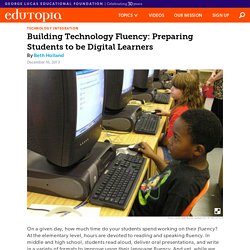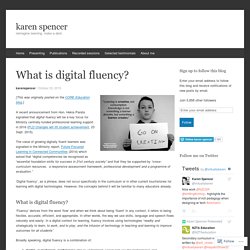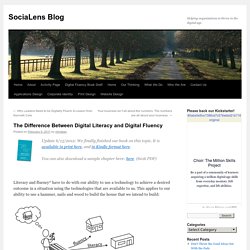

5 Ways to Grow Your Digital Fluency. If you've ever tried to define "technology," you know that it can be daunting.

A conversation about increasing digital fluency can lead to an epic list of considerations. There are so many different aspects to consider when it comes to things like technology, hardware, software, apps, social media, digital identity, and information systems. When we try to look at the big picture, it can sometimes stop us in our tracks and keep us from picking up new skills to add to our digital toolkit.
In an effort to move the technology competency needle towards a more fluent space, I present the following 5 ideas for increasing your skills when it comes to technology: Hardware: I know that this isn't necessarily about your professional fluency with technology, but having the right hardware to do your job is essential to building your digital competency. Operating Systems: If we are being completely honest, we could always improve our knowledge of the OS on our computer.
Digital fluency / Teaching. Digital fluency : skills necessary for learning in the digital ag. Building Technology Fluency: Preparing Students to be Digital Learners. On a given day, how much time do your students spend working on their fluency?

At the elementary level, hours are devoted to reading and speaking fluency. In middle and high school, students read aloud, deliver oral presentations, and write in a variety of formats to improve upon their language fluency. And yet, while we devote a significant portion of every school day to a student's reading, writing and language fluency, how much time is devoted to the development of their technology fluency? Defining Fluency When defining the concept of fluency, we first look at "speed, accuracy, ease and comprehension" (@shfarnsworth).
In school, we consider a student fluent when they read and speak the language as well as write it. Not only can a truly fluent student speak, listen, write and comprehend, but he or she can also make inferences and construct new meaning. As I'm writing this, it is Computer Science Education Week. 3 Strategies for Building Technology Fluency 1. 2. 3.
Mres wef. Towards Digital Fluency. Digital fluency » CORE Education. Whether you are renewing a prescription, communicating with others, or working across nearly any key employment disciplines you care to name, it has never been more important for people to have the knowledge, skills and dispositions to navigate online spaces confidently and successfully.

We call this ability ‘digital fluency’ and it encompasses an array of competencies and understandings that are needed for us have access to opportunities in our networked, digital societies today and in the future. This outcome of being digitally fluent relates to issues of responsibility, equity and access. We all need to be able to fully participate in a digitally-enabled education system and in an increasingly digitised society. If we work with fluency in the way we use technologies, we are able to keep ourselves safe online and take full advantage of life chance opportunities such as being able to apply for work, manage our finances, or be part of our local community. What is digital fluency? Image by George Couros under CC A recent announcement from Hon.
Hekia Parata signalled that digital fluency will be a key focus for Ministry centrally-funded professional learning support in 2016 (PLD Changes will lift student achievement, 23 Sept. 2015). The value of growing digitally fluent learners was signalled in the Ministry report, Future Focused Learning in Connected Communities (2014) which asked that “digital competencies be recognised as “essential foundation skills for success in 21st century society” and that they be supported by “cross-curriculum resources, a responsive assessment framework, professional development and a programme of evaluation.” Digital Fluency.
"Digital fluency : skills necessary for learning in the digital age" by Gerald K. White. What is digital fluency? [This was originally posted on the CORE Education blog.]

A recent announcement from Hon. Hekia Parata signalled that digital fluency will be a key focus for Ministry centrally-funded professional learning support in 2016 (PLD Changes will lift student achievement, 23 Sept. 2015). The value of growing digitally fluent learners was signalled in the Ministry report, Future Focused Learning in Connected Communities (2014) which asked that “digital competencies be recognised as “essential foundation skills for success in 21st century society” and that they be supported by “cross-curriculum resources, a responsive assessment framework, professional development and a programme of evaluation.” ‘Digital fluency’, as a phrase, does not occur specifically in the curriculum or in other current touchstones for learning with digital technologies. However, the concepts behind it will be familiar to many educators already. Digital fluency.
Digital Fluency Introduction by Michael Togher on Prezi. The Difference Between Digital Literacy and Digital Fluency. Update 6/13/2012: We finally finished our book on this topic.

It is available in print here, and in Kindle format here. You can also download a sample chapter here: here (601k PDF) Literacy and fluency* have to do with our ability to use a technology to achieve a desired outcome in a situation using the technologies that are available to us. This applies to our ability to use a hammer, nails and wood to build the house that we intend to build: ..and it applies to our ability to use digital technologies to have the intended positive effect on people and situations: Note that a literate person is perfectly capable of using the tools. *For the sake of simplicity, we have boiled all of this down to three levels of skill, and have given them what we think are easy-to-understand names. Related Posts: